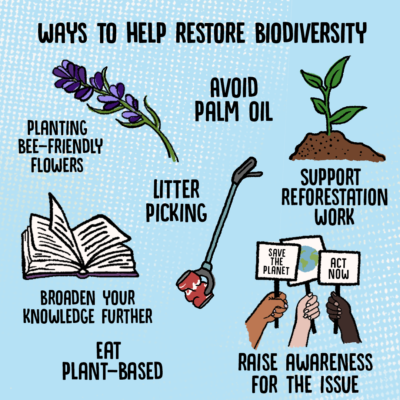Sustainability
Biodiversity is fundamental for many of the Earth’s natural processes, with entire eco systems relying on it.
To understand the catastrophic impact of biodiversity loss, it’s first important to understand what we mean by it. It’s an incredibly complex system with more cogs than you could imagine, so we’ve done our best to break it down for you.
What is biodiversity?
Biodiversity is comprised of three features: ecosystem diversity, species diversity, and genetic diversity within species. These three features spin a biodiversity ‘web’. The more diversity between and within these three groups, the more resilient the web. And, likewise, the less diversity in one of the three makes the others more vulnerable, weakening the web (1).
In some (but not all) environments, taking away one component can undermine the whole system. Take coral reefs as an example: coral is a keystone organism, providing food, shelter, and breeding grounds for many species of fish and crustaceans. If the coral dies, the other animals and organisms can no longer thrive in this ecosystem; this is happening across the Great Barrier Reef, with 50% of coral subject to ‘bleaching’ between 1995 and 2020 (2). While this is an extreme example and by no means applies to every ecosystem, it has happened before, and will happen again.
Why does it matter?
We rely on biodiversity far more than we might realise: the natural world shelters and protects us from natural disasters by regulating the climate, reducing floods, and risk of pests. We need food, clean water, and fuel sources to live on a daily basis, all of which are a result of functioning eco systems (3).
Another way we rely on biodiversity is for our food, from microorganisms that break down the soil to the insects pollenating our trees and flowers, bringing us fruits and nuts. Fungi are essential to medicine and the breaking down of organic matter, not to mention the making of bread, wine, and beer! (4)
Biodiversity loss
Biodiversity loss, or biodiversity collapse, is the reduction in the number and variation of ecosystems, species, and genetic diversity in a given area. There are 5 primary drivers of biodiversity loss: habitat loss, invasive species, over hunting/fishing, pollution, and climate change (5). Each of these drivers is influenced by human activity.
Taking deforestation as an example, we can begin to see the influence of human behavior on biodiversity loss. Forests cover 31% of the land and take in around 2.6 billion tonnes of CO2 each year, rendering them vital for stabilizing the climate (6). They also house 80% of the worlds land-based species, all of which are relying on these ecosystems to survive.
Deforestation due to agricultural expansion, forest fires, drought, invasive species, and various other drivers is causing forests to be destroyed at an alarming rate. The impact of this is catastrophic, from habitat loss causing vulnerability to hundreds of species, to an increased amount of CO2 hanging around in the air; ecosystems become less functional as animal and plant species die off and therefore less effective in absorbing CO2 (7). It’s a vicious feedback loop – biodiversity loss happens as a result of climate change, and the loss of biodiversity makes climate change worse as CO2 builds up.
What can we do to help?
We play a fundamental role in the depletion of biodiversity, yet the benefits provided by nature are indispensable for making human life possible. If that’s not reason enough to put your planet-saving cap on, we don’t know what is!
Projects and organizations that strive to protect the world’s biodiversity hotspots, such as our charity partner, Fundación Jocotoco, are pivotal in the journey to a biodiversity-rich planet. Not only do they reforest the Chocó rainforest, counteracting the effects of deforestation, they protect areas of critical importance for the conservation of threatened species in Ecuador.
While it sometimes seems like these bigger, wider-scale projects are out of our control, that’s really not the case. Think of it this way: everything we do locally has global consequences. For example, driving down the road to the shops instead of walking or cycling. It might not seem like much, it’s only a short journey, but it adds to all the other small journeys, consequently causing CO2 to build up at a rate that can no longer be used by wildlife. Plus, walking or cycling is great for your mind and body, and can help you feel more at one with nature.
There are also ways to encourage biodiversity in our own gardens, by planting bee-friendly flowers or re-wilding initiatives. Here are our tips on how to be more sustainable in your community.
If we’re to counteract biodiversity loss long-term, we must work with nature, finding ways of using land and water than leaves enough space for natural habitats to thrive. The coming together of communities is essential for this, and we must ensure that all involved have a say and a seat at the table.
If you’re keen to broaden your knowledge even further, here are some suggestions:
- Watch Kiss The Ground (2020), Netflix
- Read Braiding Sweetgrass: Indigenous Wisdom, Scientific Knowledge and the Teachings of Plants, Robin Wall Kimmerer (2020)
Check out these organisations doing inspiring, planet-saving work:
References:
- https://www.youtube.com/watch?v=GK_vRtHJZu4
- https://www.bbc.co.uk/news/world-australia-54533971
- https://www.who.int/news-room/fact-sheets/detail/biodiversity-and-health
- https://www.britannica.com/science/fungus/Importance-of-fungi
- https://www.britannica.com/study/learn-about-the-causes-of-biodiversity-loss
- https://ecologi.com/articles/blog/how-does-deforestation-impact-wildlife-and-biodiversity-what-you-need-to-know
- https://www.youtube.com/watch?v=XFmovUAWQUQ


